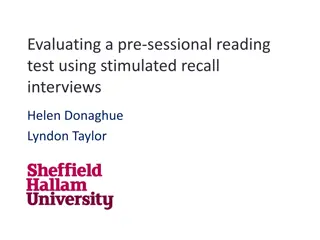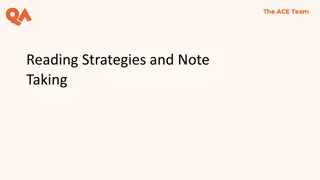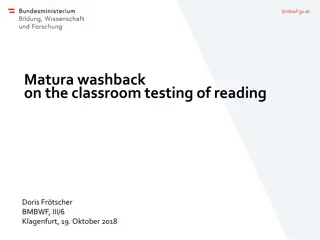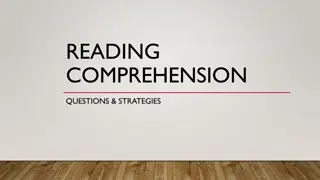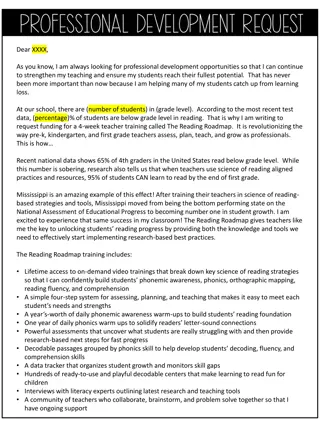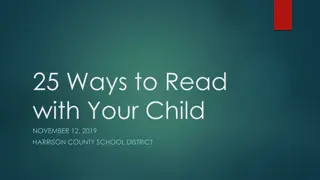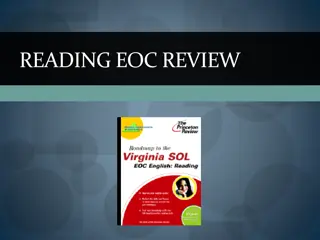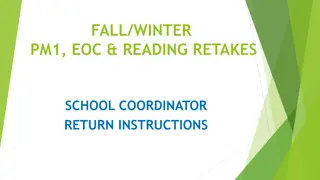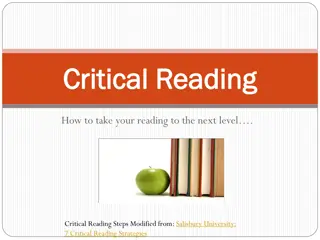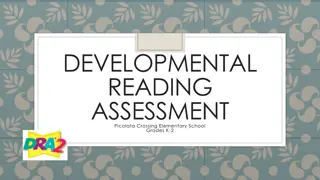Understanding the ACT Reading Test: Format, Instructions, and Strategies
The ACT Reading Test consists of 40 questions based on 4 passages, to be completed in 35 minutes. It covers prose fiction, humanities, social studies, and natural sciences. This test evaluates your ability to comprehend passages rather than memorize facts. The format includes passages of around 750 words each, with questions following each passage. Questions assess skills such as identifying main ideas, understanding relationships, making inferences, and drawing conclusions. Familiarizing yourself with the test instructions and strategies beforehand is crucial for success.
Download Presentation

Please find below an Image/Link to download the presentation.
The content on the website is provided AS IS for your information and personal use only. It may not be sold, licensed, or shared on other websites without obtaining consent from the author. Download presentation by click this link. If you encounter any issues during the download, it is possible that the publisher has removed the file from their server.
E N D
Presentation Transcript
ACT READING ACT READING
The ACT Reading Test 40 questions covering 4 passages that need to be answered within 35 minutes 8 to 8 minutes to read each passage and answer the questions.
The ACT Reading Test Questions will cover prose fiction, humanities, social studies, and the natural sciences The reading test score will include subscores on 20 questions in the Arts/Literature sections and 20 questions in the social studies/sciences sections
The ACT Reading Test The Reading Test evaluates your ability to understand the passages that are in the test, not your ability to remember facts.
Instructions for the Reading Test There s no reason to waste a single minute (or even a fraction of one) glancing at the instructions during the test. Do yourself a favor and learn them before test day. You should know the drill by now: read, repeat, remember. Rinse only after your test date. Instructions: On this test, you will have 35 minutes to read four passages and answer 40 questions (ten questions on each passage). Each set of ten questions appears directly after the relevant passage. You should select the answer choice that best answers the question. There is no time limit for work on the individual passages, so you can move freely between the passages and refer to each as often as you d like.
Format The Passages Each of the four passages is approximately 750 words long and presented in two columns. The Questions Each passage is directly followed by 10 questions of varying difficulty, making a total of 40 questions on the Reading Test. The ACT includes a number of different types of questions in each batch of 10.
Questions The questions will test your ability to: Determine the main ideas of the paragraph(s) or passage. Identify details and the meanings of those details. Understand comparative relationships (how things compare and how they contrast) Understand cause-and-effect relationships
Questions The questions will also test your ability to: Make generalizations (draw a conclusion) Figure out the meaning of words from the context Understand the sequence of events (the order in which they occur) Draw conclusions about the author s voice and approach (Inferential; you have to understand attitude and point of view of author and the main purpose of the article)
Content When we say the content of the Reading Test, we are actually referring to two different things. The first type of content refers to the subject matter of the passages. The second type refers to the sorts of questions asked about the passages. The Passages The Reading Test consists of four passages: Prose Fiction, Social Science, Humanities, and Natural Science always appearing in that order. Prose Fiction is the only fiction passage on the test; the other three are nonfiction. All four passages are given equal weight in scoring.
Prose Fiction When reading the prose fiction passage, do not just note events. Be aware of the tone and mood of the passage, the relationships of the characters, and the emotion implied by what the characters are saying. Ask yourself questions like: Who is the narrator? Does the narrator exhibit any sympathies or biases? What are the relationships between the characters? These questions will help you keep on top of the passage as you read.
Prose Fiction Questions Types of Questions Concerning Prose Fiction Identifying Specific Details Drawing Inferences Understanding Character Point of View Cause-Effect
Identifying Specific Details and Facts Specific detail questions are perhaps the most straightforward questions you ll encounter anywhere on the test. As the name suggests, these questions ask you to find specific details within the passage. They are very common on the Prose Fiction passage and throughout the rest of the test. You ll probably see three or four specific detail questions accompanying the Prose Fiction passage.
Inference Inference questions ask for implied information. They want you to take a piece of information given in the passage and use it to figure out something else. Because the answers are not given explicitly within the passage, these questions are often significantly more difficult than specific detail questions. But they are just as common, so you need to get a handle on them. You can usually spot an inference question from a mile away. Inference questions frequently use verbs such as suggest, infer, imply, and indicate.
Understanding Character Character generalization questions appear only with the Prose Fiction passage. They ask you to reduce a lot of information about a character into a simple, digestible statement. For instance, if you have a character who hates children, kicks dogs, takes candy from babies, and steals his neighbors mail, you could make the generalization that he is mean-spirited and cruel.
Point of View Point of view questions accompanying the Prose Fiction passage will generally ask you to describe the narrator s point of view. Questions that deal with other characters points of view usually fall under the heading of inference or character generalization. Point of view questions are fairly rare on the Prose Fiction passage, but you may encounter one of them on the test.
Cause-Effect These questions ask you to identify either the cause or the effect of a situation. These questions are fairly rare on the Prose Fiction passage, but you should still be prepared to answer one. You will generally recognize these questions from cue words in the question, such as resulted in and led to for effect questions, and caused by and because for cause questions. On the Prose Fiction passage, cause-effect questions will generally ask you to identify how one character s actions affected another s.
Social Studies The social studies passage will present information obtained through research. Pay attention to dates, names, and concepts. Understand cause-effect relationships, sequences of events, and comparisons.
Social Science Questions Types of Questions Concerning Social Science Specific Detail Inference Main Idea and Argument Cause-Effect Point of View Comparison Vocabulary
Specific Detail Specific detail questions on the nonfiction passages are as straightforward as they are on the fiction passage. They ask you to identify a specific detail or piece of evidence from the passage.
Inference You may remember that inference questions ask for implied information. The answers to inference questions won t be stated explicitly in the nonfiction passages; instead, you must ferret out the answer from the evidence provided by the passage.
Main Idea and Argument On the nonfiction passages, you ll encounter quite a few main idea questions. Some of the questions will deal with the passage as a whole, while others will deal with sections of the passage. In both cases, these questions will ask you to identify the main ideas or arguments presented within the passage.
Cause-Effect As with their Prose Fiction counterparts, cause- effect questions on the nonfiction passages will ask you to identify either the cause or the effect of a particular situation. You are more likely to see these questions on Social Science and Natural Science passages than on Humanities passages because the science passages often describe sequences of events. Cue words in the question will let you know whether you must identify the cause or the effect of the relationship. Words such as because warn you that the question seeks the cause of an event, while words such as resulted in, led to, and caused let you know you ll need to identify the effect of a situation.
Point of View Point-of-view questions on the nonfiction passages differ somewhat from those on the Prose Fiction passage. As opposed to the fiction point-of-view questions, which ask you to identify the point of view of the narrator (a fictional invention), the nonfiction point-of- view questions ask you to identify how the writer (a real person) views his or her subject. As you read a passage, consider whether the writer s argument seems to support or attack the passage s subject, and pay attention to the language the writer uses. The writer s tone (is it angry? is it sympathetic?) will be a good indication of his or her feelings about the subject.
Comparison As the name implies, comparison questions ask you to make comparisons, usually between different viewpoints or data. Comparisons can be tricky questions to handle because you need to assimilate information on both sides of the comparison and then see how the sides compare. You ll see these types of questions more frequently on the Social Science and Natural Science passages than on the Humanities passage because the Science passages usually contain a lot of factual information. You probably won t encounter more than a couple of these questions on the entire test. The question will contain cue words or phrases that indicate it s a comparison question. Compares and analogy are two words that frequently appear in comparison questions.
Vocabulary Vocabulary questions ask you to decipher the meaning of a word given its context. Usually, these words will have multiple meanings, so you must decide the function of the word in the specific context. You will immediately recognize these questions from their formulaic phrasing. They provide you with a line number along with an italicized word or short phrase in quotation marks, and then they ask you to provide the meaning of the word in context.
Humanities The humanities passage is factual, not fiction. It will generally deal with a topic of cultural interest. You can think of it as a softer version of the social science passage, which tends to have of an analytical and political angle. The information presented in the humanities passage is important, but you also need to pay attention to the author and his or her point of view. You may be asked to project how the author would respond to a situation based on what the passage says about the author s opinions.
Humanities The passage may have characters who are historical or contemporary people who have lived, not fictional characters like those in the prose fiction passages. You will be asked to infer or identify relationships between ideas, events, trends, people, or thoughts.
Questions Types of Questions Concerning Humanities Passage Specific Detail Inference Vocabulary Main Idea Comparison
Specific Detail Specific detail questions on the Humanities passage are exactly the same as on the rest of the test.
Inference By now, you should have a good idea of how to answer inference questions.
Vocabulary The Humanities passage often contains a number of vocabulary questions, so be on the lookout.
Main Idea Main idea questions tend to accompany Humanities passages that are more analytical or journalistic in tone than the sample passage above. With anecdotal passages like this, it s unlikely that you ll be asked to identify the main point of the passage or of a paragraph the anecdote itself is usually the point. If you do face a main idea question, use the same strategy that we covered under the Social Science passage.
Comparison Refer to notes from Social Science passage
Natural Sciences On the continuum of Reading Test passages, the Prose Fiction passage would be on one extreme, the Social Science and Humanities passages in the middle, and the Natural Science passage at the other extreme end. The Natural Science passage is heavy on scientific facts, argument, cause-effect logic, and details.
Natural Sciences The natural sciences passage will usually present you with a scientific topic and the significance of this topic. Be aware of cause-effect relationships between natural phenomena. Be aware of comparisons and sequences of events.
Natural Sciences Track but do not memorize rules, theories, or scientific laws that are mentioned. If jargon or technical language is used, the passage will help you understand the meaning from the context in which it is used.
Questions Types of Questions Concerning Natural Science: Specific Detail Inference Cause-Effect Comparison Main Idea Vocabulary Point of View
Main Idea Main idea questions are always pretty straightforward. The tricky part is making sure that you read carefully enough to understand the main point of the passage or of a paragraph within it.
Vocabulary You will not see many vocabulary questions accompanying the Natural Science passage. The vocabulary questions that do appear on this passage may ask you to identify an unfamiliar scientific word from its context.
Point of View Point-of-view questions are extremely rare on the Natural Science passage. If you see one, it will most likely ask you to identify the point of view of the passage s author.
Types of Questions Two types of questions are used: Referring Reasoning
Test Taking Strategies Pace Yourself 2-3 minutes on each passage and an average of 35 seconds to answer each question Think of the test as four 8 minute sections If you are a slower reader, preview the questions and then look at or scan the passage for the answers
Test Taking Strategies Answer all questions, even if you have to guess Keep the passage as whole in mind as you answer the questions Read quickly but carefully. Know what each question asks and select the best answer Sample practice tests will help you get a complete picture


